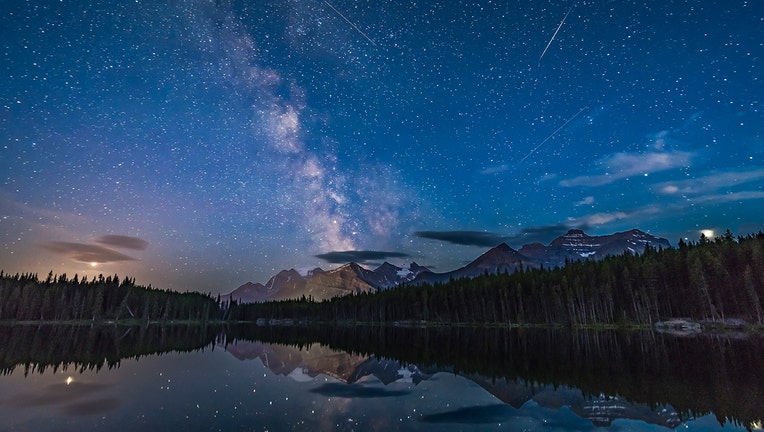Astronomers discover huge galactic wall hidden behind Milky Way

The view looking south at Herbert Lake, Banff National Park, Alberta, with the Milky Way over Mount Temple. Jupiter flanks the Milky Way on the right, while Saturn sits within the Milky Way. (VW Pics/Universal Images Group via Getty Images)
FOX NEWS - Scientists have discovered a celestial structure made of galaxies more than 1.4 billion light-years long and 600 million light-years deep in the skies over the South Pole, according to a report.
The South Pole Wall, as it has been dubbed, is situated along the southern border of the cosmos from the perspective of Earth, and consists of thousands of galaxies, hydrogen gas, dust and dark matter, Vice and MIT Technology Review explains. It's also one of the largest known structures in the universe.
Download the FOX 5 DC News App for Local Breaking News and Weather
The wall is among a number of structures that make up the cosmic web, including the Great Wall, the Bootes Void, the comparably sized Sloan Great Wall and the Hercules Corona-Borealis Great Wall, the largest known structure at 10 billion light-years wide, according to MIT.
That’s about a tenth of the diameter of the observable universe, Vice reported.
The findings were first announced last Friday in the Astrophysical Journal.
RELATED: Scientists estimate at least 36 ‘Extra-Terrestrial Intelligent’ civilizations are in our galaxy
The South Pole Wall, however, is half the distance from the Earth to the Hercules Corona-Borealis Great Wall – 500 million light-years – and was hidden by the brightness of the Milky Way in an area called the Zone of Avoidance, according to MIT.
It was discovered when scientists saw galaxies in different directions around it were affected by its gravitational pull.
The wall is the largest structure discovered within a 650 million light-year radius from Earth, according to Vice.
“When our visualizations indicated something going on at the celestial South Pole, we were surprised,” Paris-Saclay University in France cosmographer Daniel Pomarède, told Vice in an email. “Indeed, there were no reports of a large scale structure in this region.”
READ MORE: Look out, Mars: Here we come with a fleet of spacecraft
Pomarède told Vice that the wall’s bow-like makeup is the reason its “length can fit the observed sphere,” adding the map the scientists used “fades away just beyond the wall. So, perhaps we are not seeing the whole of it, if it happens to bend away from us beyond our observational limit.”

